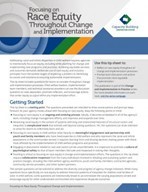|
Applying structured change and implementation processes can help child welfare agencies and their system partners analyze the challenges they face and select and implement appropriate solutions[1]. Unfortunately, racial equity is often an overlooked part of these processes. Without an intentional focus on equity during planning and implementation, agencies risk their programs, practices, and policies being inappropriate or inconsequential to the children, youth, and families served, and equitable outcomes (e.g., reduced disparities in time spent in out-of-home care) are unlikely to follow.
Focusing on equity requires deliberate attention over the course of implementation to questions like:
-
How has your agency explored the underlying reasons for its problems and the varying experiences for different racial and ethnic groups?
- How are youth and families with lived experience involved in selecting programs and strategies to address identified problems?
- How can a program or strategy be adapted to be more accessible and responsive to populations in the community?
- What steps are taken to learn from the community about what’s working and what isn’t?
A key part of advancing racial equity is meaningful engagement and partnerships. Engagement is more than simply inquiring about what a community needs; true engagement incorporates youth and families with lived expertise in the early stages of planning and enables them to lead the way in putting solutions in place.
Facts
- In 2020, Black or African-American children accounted for 14 percent of the total U.S. child population and 23 percent of the foster care population; American Indian and Alaska Native children made up 1 percent (total) and 2 percent (foster care); White children made up 50 percent (total) and 43 percent (foster care)[2],[3]. State rates of disproportionate representation vary and can be even more pronounced.
- Close partnerships with the individuals most affected contribute to increased rigor of implementation efforts—beginning with collaborative identification of the problems to be addressed through the selection or creation of an appropriate intervention, its implementation, and evaluation[4].
- Case studies suggest that taking action to address equity begins with honest and sincere conversations about racial inequities[5].
The Capacity Building Center for States (the Center) encourages child welfare agencies to focus intentionally on racial equity, partner meaningfully with youth and families with lived expertise, and leverage data and evidence throughout change initiatives. Access the Center’s resources listed below to support reflection and conversations around race equity.

Publications and Series
|
Learning Experiences and Recorded Webinars
Advancing Racial Equity in Child Welfare: Child Welfare Virtual Expo 2021 (recorded virtual conference and discussion guide). Includes videos, conversation starters, and activities on:
Access to Expertise
The Center can support public child welfare agencies in their efforts to advance racial equity, including by helping to bring teams together to analyze data and discuss what they mean.
For more information on services tailored to your child welfare agency’s needs, contact your Center for States Tailored Services Liaison or email capacityinfo@icfi.com.
Related Resources
Related Organizations
-
FRIENDS – Provides technical assistance and training to the Community-Based Child Abuse Prevention (CBCAP) community and supports family-serving organizations in becoming culturally effective.
-
National Child Welfare Workforce Institute – Develops and supports a child welfare workforce that can equitably meet the needs of vulnerable children and families.
Did you receive this message from a friend? Get it delivered to your inbox.
|